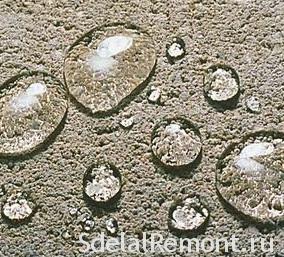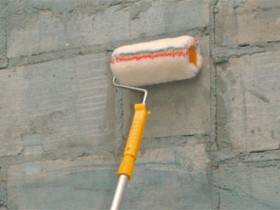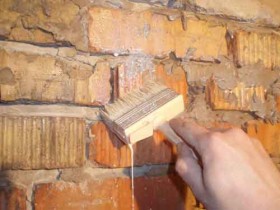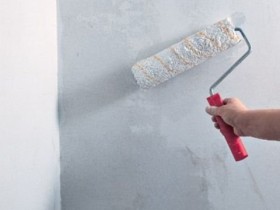One of the most important elements of any repairs and construction is to wash the walls. What is she like?

Primer for walls, floors, ceilings and any other building element is designed to solve a huge pile of problems. Chief among them is the bonding base. It creates a strong film, which is able to withstand heavy loads. This it manages by allowing deep penetration. These properties are acrylic types of primers, for concrete, plastered and plastered walls.
Chemically active formula by reaction with the oxygen starts to polymerize (zatverdevat). In the plane of drawing substances grow long artificial polymer crystals, which form strong bonds with one another.
The second task, to be pursued and successfully implementing a primer - a waterproofing. By forming a dense film on the base surface moisture is no room for the penetration inside wall. But it is a porous structure.

Important function of any primer for the walls is corrosion protection and antiseptic. When applying it to the metal surface it provides maximum grip topcoats base, material that provides resistance to wet environments. When using primers for loose walls (brick, ASG unit, plaster, putty), it acts as an antiseptic. Killing various microbes, which are even deep into the structure of the material and create antiusloviya for their future existence and occurrence.
The types of primers for walls
Today produced different types of primer mixtures for the various types of base materials walls:
- for metal substrates;
- Bulk Cement porous structures;
- for wood.
On sale there are also some types of primers, which is securely fastened even with plastic products, which then allows them plaster, plaster or painting. It is composed of Compounding and resinous components.

Priming the walls under the wallpaper, final coating which is substantially putty, It becomes an integral process of repair work. Here, mixtures of acrylic-based. They possess excellent penetration, to provide a solid and reliable basis. Especially for wallpaper is necessary and. However, even the wallpaper paste can be used for the treatment of walls of loose materials. It has all the same properties, that of acrylic primer, moreover, owing to the rather thick consistency the resulting mixture may be a means for aligning the microcracks, micropores and other fine surface defects.
When preparing homemade primer for walls, to maximize the quality of the texture. To a perfectly smooth wall was not solidified clots and specks, with stirring in a container of glue inserted piece of fiberglass mesh. It stick all the pieces of the undissolved adhesive and debris, that will further allow unimpeded dip the roller into the container.
If the walls are made of wood, which in the future it is necessary to hang wallpaper, here are used alkyd primer. They have a characteristic pungent odor, so the room should be well ventilated. Primer plaster this material creates a durable coating, because it penetrates deep into the wood structure, bonding and preventing its desiccation. Besides, it is also a good remedy against various parasites.
On sale also there is still a primer concentrate for walls, ceilings and floors of the bulk surface of wood and. This highly concentrated substance, called acrylic dispersion, before use is diluted with water in various proportions. components depend on the proportion of future work.
for example, Armor primer concentrate is mixed with water in the following proportions:
for facade work - 1:0,6;
for the purpose of work - 1:0,8;
Interior finishing - 1:1.
The proportions of dilution with water and flow rate 1 m2 the area indicated on the packaging, therefore, prior to use of a concentrate, Thoroughly read the instruction.
Priming of walls before plastering

Primer for plaster plays the most important role in the whole process of construction or repair. When the walls of the block ASG, brick or concrete at its surface is always present fine particles of the same material. They will be an obstacle to a lasting solution contact plastering walls and even a strong adhesive for tiles. Primer for plaster walls to resolve the issue of education chalk dust on the surface of these materials, fixedly fastened with their base structure. Many people mistakenly believe, that the wall just enough to moisten with water, and the solution will be fine to stay. But it is not so, because after even a small amount of time on a section of the wall is clearly visible from the backlog of plaster blocks or bricks, and this can nullify all the work carried out. Therefore, to avoid these hassles and unexpected costs later, It should be carried out this important step. Thus necessarily need to wait for the complete drying time before further processing works. If loose and suspicious surface for plaster walls Primer to be realized several times, giving the previous layer to dry completely.

drying time and concentration of the dilution of primers is always indicated on the package, so be sure to read the instructions before it is used. The average polymerization surface after treatment period is 24 hours at normal humidity and at a temperature not lower than 150WITH.
To wash the walls before painting

Today, there are many ways of wall decoration, which are subsequently painted paints of different types. But its lasting adhesion to the surface is also required to wash the walls before painting. Thus, depending on the type of finishing coating is chosen and the type or number of layers of coats. For water-based exterior paints, and quite a layer of soil, but using oil or other types of coatings, it is better to make the processing of several layers.
for priming the walls of the technology and tools
Choosing the type of material, Now we shall understand, both primed the walls for painting.
To carry out works on priming the walls need to roll, Soil brush and container.
Many types of soil, even almost all, begin immediately fasten. Therefore, necessarily and personal protective equipment. This rubber gloves, hat and breeches appropriate clothing.
Brush is recommended for high-quality processing places, in which the roller can not penetrate, even with long pile:
- angles;
- dimples;
- openings;
- projections;
- decorative elements.
Thus the brush bristles can be any non-rigid, not to damage the base (putty). The roller should be used foam, velor or pile.
Applying the primer it is important to remember that, that can damage the base with a strong wetting surface. This is especially true putty. Therefore soil deposition process on the surface is best carried out in one motion in one place.
Below is a short video, which deals with the basic principles of priming the walls.













When we plastered wall, an integral part of the process has been primed. Priming the walls is an important element, bad surface treatment of the walls prior to application of the plaster may cause, that the finish coat will quickly become worthless. In this primer repair master applied to each layer of plaster for greater reliability and antiseptic effect.